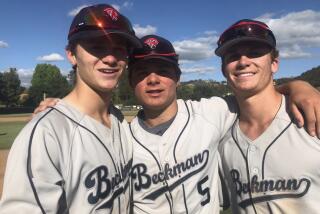Bradbury Moves to Mariner Organization
The best wedding present Miah Bradbury received came in the form of a phone call.
Bradbury and his wife, Lara, married on Nov. 23, had just returned from their honeymoon in Big Bear when it came.
Ring.
“Hello Miah, this is (so-and-so) from the Seattle Mariners. How would you like a real shot at playing in the big leagues?”
OK, so that was not the precise terminology used, but it might as well have been.
The Mariners had just purchased Bradbury’s contract from the Miami Miracle, an independent Class-A team.
For Bradbury, 24, getting out of Miami was a miracle.
“When the Mariners called, it was almost like getting drafted again, only better,” said Bradbury, a former standout catcher at Mt. Carmel High and Loyola Marymount University. “They gave me a new lease on my baseball career. Finally, I was going to play for an organization. Finally, I was going to have an opportunity to play for advancement . . .
“When they called, that was one of the happiest days of my life. I was ecstatic. I was jumping around the room. I couldn’t control myself I was so happy.”
Not that Miami was such a terrible place for a recent college graduate to play. Bradbury rather enjoyed his two seasons there.
He, and most of his teammates, lived in a resort-like apartment building overlooking Pompano Beach.
“It was sort of like being on vacation,” Bradbury said. “There was plenty of fishing, we had volleyball courts, and the beach was right there. You couldn’t ask for more in accommodations.”
The problem was, he was a minor-league baseball player, and minor-league baseball players aspire to move up. That much was difficult with the Miracle, and there was little he could do about it.
Bradbury was drafted twice by the Philadelphia Phillies’ organization--once out of Mt. Carmel and again after his junior at Loyola--but he opted both times to remain in school.
After earning his degree in English literature and completing his senior season at Loyola, he was drafted a third time, in the fifth round of the 1990 June amateur draft by the Miracle.
“I was shocked when I got drafted by them,” Bradbury said. “I was looking forward to being picked by an organization.”
Incidentally, 1990 was the only year that independent teams were permitted to draft players.
“There are some of us still shaking our heads over that draft,” said Bradbury, in reference to the independents gaining draft status for that year. “Some of us were lucky enough to get picked up by an organization, but there are some that got robbed of their chance. I feel for those guys.”
An All-American at Loyola, where he was also a three-time all-West Coast Conference selection and the player of the year in 1990, Bradbury hit only .210 with four home runs and nine RBIs in 50 games his first year with Miami.
After a slow start in 1991, he caught fire in the second half of the season and wound up with a .272 average, seven homers and 45 RBIs. In addition to being selected for the Florida State League all-star game, Bradury led the league by throwing out 53 would-be base stealers in 109 games and fielding percentage (.990) for catchers.
That was enough to get the Mariners’ attention, but not enough to thrill them. He was assigned to play a third season in Class A--for the Peninsula (Hampton, Va.) Pilots of the Carolina League.
Though disappointed, any complaints about his assignment have come not from Bradbury but opposing pitchers and managers. Through Tuesday, he led the Carolina League in batting with a .322 average (65 for 202) and had eight doubles, four home runs and 28 RBIs.
Defensively, he has made only two errors (both were on catcher’s interference calls) and his pitchers’ earned run average (2.90) is the lowest in the league.
“The general consensus around here is he definitely does not belong in single-A ball,” Stuart Sherman, the Pilots’ public relations director, said.
“I try not to get caught up in those things,” Bradbury said. “Something Coach (Dave) Snow taught me at LMU was don’t get caught up in things you can’t control. What happens happens. I believe things happen for a reason. I believe I’m here for a reason. If it should happen that I get promoted, then it will happen. I’m just trying to have some fun in the meantime.
“The way I look at it, I’m taking the long way to the big leagues. I’m taking the longest possible route. But I’m not bitter. There are guys who have had far worse careers than myself.
“If I can hang in there and someday make it to the big leagues, I’d be the happiest guy on the planet. And I’m already a pretty happy guy.”
Catching on: Eric Helfand, like Bradbury, is bucking for a promotion from Class A.
Helfand, a catcher from Patrick Henry and Arizona State, is batting .310 with 15 doubles, 10 home runs, 44 RBIs and a .433 on-base percentage in 67 games at Modesto, an affiliate of the Oakland Athletics.
In addition, the left-handed hitting Helfand was named the most valuable player in the June 18 California League all-star game after collecting two hits and three RBIs, including a key two-run homer, in his side’s 5-4 victory. Earlier that day, he won the league’s home run derby.
“He’s improved tremendously in all categories this year,” said Modesto Manager Ted Kubiak, who played for the Padres in 1975 and 1976. “From his physical strength to taking care of pitchers and running a game, he’s really made some big strides. He’s definitely one of our brighter prospects. If he continues to improve, he’s going to play a long time in the big leagues.”
The gauge: The thing that separates Bradbury and Helfand from mediocre catchers is their ability to handle pitchers and call games, said Sean Rees, a pitcher from Mission Bay High.
Bradbury and Rees are batterymates for the Peninsula Pilots, and Helfand used to catch Rees while the two were at Arizona State.
“They’re the two best catchers I’ve ever thrown to,” said Rees, who is 7-6 with a 3.22 ERA. “They really know how to call a game, and that makes a big difference to a pitcher. You don’t ever have to worry about second-guessing them.
“That’s the thing about catching. Anybody can get back there if they have a decent arm and a little skill. But it’s the way they call games and set up batters that sets them apart.”
No pit stop: They call him gas, and his motor is purring. No other professional baseball players has more stolen bases than Essex Burton, a Madison High graduate now playing second base for South Bend (Ind.), a Class-A club in the Chicago White Sox chain.
Burton has 42 stolen bases in 63 games and has been caught stealing 12 times.
Highlighting back-to-back four-hit games on June 14-15, Burton stole five bases in the first game, tying him with Jacksonville’s Jesus Tavarez for the most steals by a minor-league player in one game this season.
Easy as free throws: Having not played baseball since 1990 because of an ailing back, it took San Diego State basketball player Tony Clark a few swings to get in the groove this season for the Detroit Tigers’ Class-A affiliate in Niagara Falls, N.Y.
Clark, the No. 2 overall selection in the 1990 amateur draft out of Christian High, had only four hits in his first 21 at-bats (.190) since his rookie season, when he hit .164 with one home run in 25 games.
In his last six games, however, Clark is 11 for 21 (.524) and had his first two-homer game last Thursday. For the season, he’s hitting .357 (15 for 42) with four doubles, three home runs and 10 RBIs in 13 games.
Sally stars: Benji Gil, the Texas Rangers’ 1991 No. 1 draft choice out of Castle Park, went one for three in the South Atlantic League all-star game on June 21. Gil is batting .267 with four homers, 30 RBIs and 15 stolen bases for Class-A Gastonia (N.C.).
St. Louis Cardinal prospect Rigo Beltran, a left-handed pitcher from Point Loma High and Mesa College, had to miss that all-star game because of stiffness in his pitching shoulder. Beltran is 6-1 with a 2.17 ERA and 106 strikeouts in 83 innings for Savannah (Ga.).


